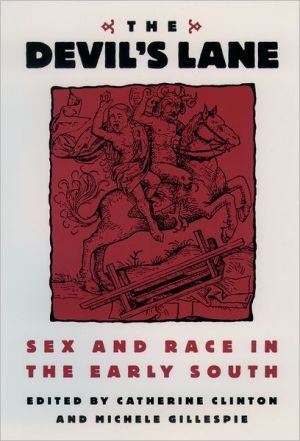

 |

|

The average rating for The Devil's Lane: Sex and Race in the Early South based on 2 reviews is 4 stars.
Review # 1 was written on 2010-12-13 00:00:00 Jay Brewer Jay BrewerDL text: Indian Foremothers by Peter Wallenstein Race, Sex, Slavery and Freedom discussion Multiply located across racial groups 1. "Being multi-racial is a question of which racial category is more dominant physically than any other category"'historically, dominant membership of a specific racial category mattered because it ensured membership rights and restrictions belonging to that racial group. Featherstone talks about Indians never being slaves vs. blacks always being slaves. Here is a racial conflict for people who had no choice to racially identify as black in the Upper South. Pretty much Indian ancestry and not whiteness assured Featherstone her "free birth and free life," in the 1850s Despite African ancestry'if a group claimed "Indian Foremothers" they were free in Virginia. -Race starts out biological and adjusts to fit societal views. This is true because racial categories are complex and legislature in Virginia in 1662 defines how children of Black Women and White men aren't born into freedom. They receive their mother's legacy of imprisonment and how women's status was subjugated beneath men's. -Thus, slave women would have slave children regardless of who the father is and contrary-wise white women would have free children, again no matter who the father is (58). Here because of the Virginia legislature men aren't kept to the same laws as women. This creates a social inequity between women's racial categories and men's, proving the importance of women's to be greater than men in order to tolerate women. The laws condoned ostracism of white women who had sex with black men and gave birth to mixed children for five years. -The law didn't include women who had children with Indian fathers. In this way women's ability to name membership in multiple racial categories (e.g. women born to white women and Indian men) aren't as able to name their presence in these categories as women who are punished for birth of mulattos. It was negative for either woman. 1. What is the argument or the theme of the reading? A common theme that both Gilispie and Wallenstein share is the sexual politics of race and gender. Women's citizenship is subject to increase with rights or restrictions based on sex and race. White women having sex with black men went against the laws in Virginia commonwealth in the late eighteenth century. During this time period, unstable boundaries of racial and ethnic difference were erected . Much of the instability, though, emphasizes the laws, court cases, social science, and sensationalized mass media that structured interracial sex and marriage as illicit, the multifaceted surveillance that restricted sexual behavior, and the sexual vulnerability and stigmatization of various subjugated groups The author challenges how race is socially complex, meaning that when an individual historically receives a racial label because of the inheritance of his mother or the matrilineal decendance, this label contains artificiality and permeability of political borders. 1. Who did the burden of proof fall on and why, when it came to proving whether a mixed individual was free or subject to endure slavery? 2. Who were the "true emancipators" outlined by Wallenstein? Why? What if (any) were the discrepancies between those distinctive legal cases of members claiming to have true Indian ancestry? 3. How did race start out as a biological concept and adjust to fit the societal lens of the late 1790s? (Hint: describe the process of racial identification depending upon one's racial inheritance from the mother that was legalized/ legitimized at the time). 4. How was slavery in Virginia redefined based on dislike of blacks and of indifference of native American Indians from 1780-1810? 5. What three ways did non-white Virginians grow demographically in the late eighteenth century? 6. Based on how the non-white Virginia population grew, how was this growth both a social victory and a defeat to blacks in the South? 7. The Wallenstein reading about Virginia commonwealth, which means "government based on the common consent of the people," looks closely at a double-standard. How, then, were laws constructed to criminalize women and pardon men in regards sexual expression with mixed-blooded partners? 8. According to specific examples given by Carson and also by Wallenstein how were the effects of colonialism responsible for the exploitation of women, collectively, when it came to the moral economy? 9. Was the deerskin trade good or bad as an effect of colonialism for women? Why or why not? 10. How is sewing kernels of green corn (an act done by women) a relevant parallel to the reinforcement of gender subordination for bi-racial women, who identified as "Indian" both in the lower and upper regions of the South during the late 1700s? (Hint: for this question discuss the connection of how a woman's worth is equated). 11. How did women lack authority when it came to receiving lands that were promised to them from the colonists? |
Review # 2 was written on 2015-04-24 00:00:00 Barbara Osheim Barbara OsheimA collection of essays, divided into regions of the South. Some focus on a specific case study, others describe a social group in general. |
CAN'T FIND WHAT YOU'RE LOOKING FOR? CLICK HERE!!!